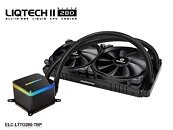- Joined
- Oct 9, 2007
- Messages
- 47,886 (7.38/day)
- Location
- Dublin, Ireland
| System Name | RBMK-1000 |
|---|---|
| Processor | AMD Ryzen 7 5700G |
| Motherboard | Gigabyte B550 AORUS Elite V2 |
| Cooling | DeepCool Gammax L240 V2 |
| Memory | 2x 16GB DDR4-3200 |
| Video Card(s) | Galax RTX 4070 Ti EX |
| Storage | Samsung 990 1TB |
| Display(s) | BenQ 1440p 60 Hz 27-inch |
| Case | Corsair Carbide 100R |
| Audio Device(s) | ASUS SupremeFX S1220A |
| Power Supply | Cooler Master MWE Gold 650W |
| Mouse | ASUS ROG Strix Impact |
| Keyboard | Gamdias Hermes E2 |
| Software | Windows 11 Pro |
ENERMAX, a leading designer and manufacturer of high-performance PC hardware products, announces the launch of a new all-in-one liquid cooler series, LIQTECH II. Responding the market demand of cooling solution for high-end CPUs, LIQTECH II can deliver enthusiast-grade cooling capacity of 500+ watts (TDP) and is compatible with both Intel and AMD sockets (except AMD sTR4).
Furthermore, certified by main motherboard makers (ASRock, ASUS, Gigabyte, and MSI), LIQTECH II can support the latest addressable RGB lighting synchronization with advanced motherboards featuring addressable RGB headers (pin assignment: 5V/D/-/G) to create dynamic visual effects. LIQTECH II is perfect for overclocked systems, image editing workstations, and high-end gaming machines.




Extreme High Cooling Capacity of TDP 500+ Watts for Intel and AMD CPUs
LIQTECH II, a universal Intel and AMD CPU cooler series, has extremely high cooling capacity of TDP 500+ watts, which can also easily handle a large amount of heat generated by the heavily overclocked CPUs. Thanks to ENERMAX patented SCT (Shunt Channel Technology) cold plate design to deliver 30% more heat exchange efficiency, LIQTECH II can offer superior, reliable cooling performance. Besides, LIQTECH Il comes with the powerful ENERMAX EF1 pump, equipped with a high-efficiency ceramic nano PI bearing, can produce high flow rate up to 450 L/h, which is 7 times stronger than its peers.
Premium Addressable RGB Water Block
The water block of LIQTECH II features a premium acrylic cover and a vivid Aurabelt, an exquisite LED lighting design to provide unique visual experience. Moreover, LIQTECH II offers 2 ways to control the RGB lighting effects. Users can program preferred lighting via RGB motherboard software to match the colors with other RGB components. Or, users can use the included control box to select preferred lighting effects (10 pre-set effects), colors, brightness and speed.
LIQTECH II series comes in 3 different radiator sizes: 360, 280 and 240mm; meanwhile, the new lineup also has a special edition of 360mm radiator in white. LIQTECH II includes universal mounting kits, supporting the latest sockets of Intel (LGA2066/2011-3/2011/1366/1156/ 1155/1151/1150) and AMD (AM4/AM3+/AM3/AM2+/AM2/FM2+/FM2/FM1).
LIQTECH II will be available at retail in early December of 2018.
For more information, visit this page.
View at TechPowerUp Main Site
Furthermore, certified by main motherboard makers (ASRock, ASUS, Gigabyte, and MSI), LIQTECH II can support the latest addressable RGB lighting synchronization with advanced motherboards featuring addressable RGB headers (pin assignment: 5V/D/-/G) to create dynamic visual effects. LIQTECH II is perfect for overclocked systems, image editing workstations, and high-end gaming machines.




Extreme High Cooling Capacity of TDP 500+ Watts for Intel and AMD CPUs
LIQTECH II, a universal Intel and AMD CPU cooler series, has extremely high cooling capacity of TDP 500+ watts, which can also easily handle a large amount of heat generated by the heavily overclocked CPUs. Thanks to ENERMAX patented SCT (Shunt Channel Technology) cold plate design to deliver 30% more heat exchange efficiency, LIQTECH II can offer superior, reliable cooling performance. Besides, LIQTECH Il comes with the powerful ENERMAX EF1 pump, equipped with a high-efficiency ceramic nano PI bearing, can produce high flow rate up to 450 L/h, which is 7 times stronger than its peers.
Premium Addressable RGB Water Block
The water block of LIQTECH II features a premium acrylic cover and a vivid Aurabelt, an exquisite LED lighting design to provide unique visual experience. Moreover, LIQTECH II offers 2 ways to control the RGB lighting effects. Users can program preferred lighting via RGB motherboard software to match the colors with other RGB components. Or, users can use the included control box to select preferred lighting effects (10 pre-set effects), colors, brightness and speed.
LIQTECH II series comes in 3 different radiator sizes: 360, 280 and 240mm; meanwhile, the new lineup also has a special edition of 360mm radiator in white. LIQTECH II includes universal mounting kits, supporting the latest sockets of Intel (LGA2066/2011-3/2011/1366/1156/ 1155/1151/1150) and AMD (AM4/AM3+/AM3/AM2+/AM2/FM2+/FM2/FM1).
LIQTECH II will be available at retail in early December of 2018.
For more information, visit this page.
View at TechPowerUp Main Site



